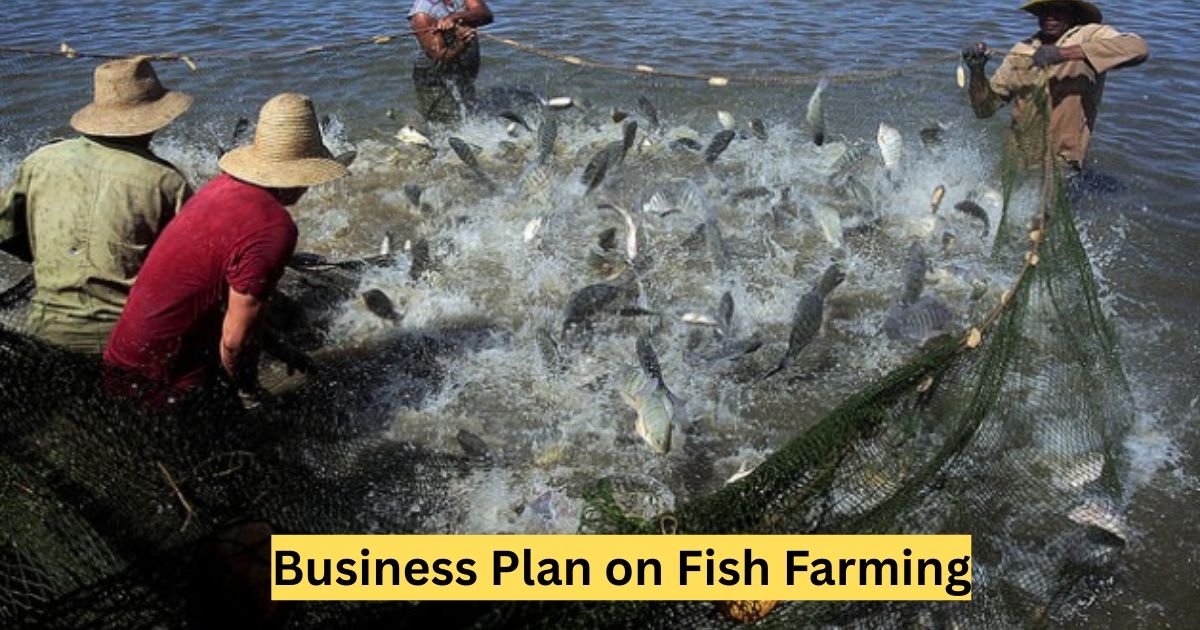Fish farming, or aquaculture, is a booming industry that offers sustainable solutions to meet the growing global demand for seafood. With the world’s population projected to reach 9.7 billion by 2050, fish farming provides an eco-friendly way to produce protein-rich food while reducing pressure on wild fish stocks. A well-structured business plan is crucial for success in this venture. This article outlines how to create a detailed, actionable business plan for fish farming, packed with practical tips, real-world examples, and data-driven insights.
Why Start a Fish Farming Business?
Fish farming is a lucrative and sustainable business opportunity. According to the Food and Agriculture Organization (FAO), global aquaculture production reached 82.1 million tonnes in 2020, contributing over 50% of the world’s fish consumption. The industry is expected to grow at a CAGR of 5.8% from 2021 to 2028.
-
High demand: Seafood consumption is rising due to its health benefits, including omega-3 fatty acids.
-
Scalability: Fish farming can start small and expand as profits grow.
-
Sustainability: Reduces overfishing and supports environmental conservation.
-
Profitability: High returns with proper management, especially for species like tilapia, catfish, and salmon.
Featured Snippet Answer: Why start a fish farming business? Fish farming is profitable, sustainable, and meets the rising global demand for seafood, with aquaculture producing over 50% of the world’s fish supply.
Key Components of a Fish Farming Business Plan
A fish farming business plan serves as a roadmap for success. It outlines your goals, strategies, and financial projections. Below are the essential sections to include, tailored for aquaculture.
Executive Summary
The executive summary is a snapshot of your fish farming business. It should be concise yet compelling, summarizing your mission, vision, and objectives.
-
Mission: To provide high-quality, sustainable fish to local and regional markets.
-
Vision: To become a leading aquaculture provider using eco-friendly practices.
-
Objectives: Achieve $100,000 in revenue in the first year, expand to 5 ponds within 3 years, and maintain a 20% profit margin.
Example: AquaGrow Farms, a tilapia farming startup in Nigeria, used a clear executive summary to secure $50,000 in funding by highlighting their sustainable practices and local market focus.
Market Analysis
Understanding your market is critical. Research consumer preferences, competitors, and industry trends.
-
Target Market: Local restaurants, supermarkets, and health-conscious consumers.
-
Demand Trends: Tilapia and catfish are popular due to their fast growth and affordability.
-
Competitor Analysis: Identify local fish farms and their pricing. For instance, small-scale farms in India often sell tilapia at $2–$3 per kg.
-
Opportunities: Growing demand for organic and locally sourced fish.
Data Insight: The global tilapia market was valued at $7.5 billion in 2022 and is expected to grow due to its affordability and versatility.
Question-Based Subheading: What is the target market for fish farming?
The target market includes restaurants, grocery stores, and health-conscious consumers seeking affordable, sustainable seafood.
Business Model
Your business model defines how you’ll generate revenue. Common fish farming models include:
-
Pond-based farming: Cost-effective for tilapia and catfish.
-
Cage farming: Suitable for open water bodies like lakes or rivers.
-
Recirculating Aquaculture Systems (RAS): High-tech, water-efficient systems for premium species like salmon.
-
Integrated farming: Combining fish with crops (e.g., rice-fish farming) for added income.
Practical Tip: Start with a pond-based system if you’re a beginner. It requires less capital ($5,000–$10,000) compared to RAS ($50,000+).
Operational Plan
This section details the day-to-day operations of your fish farm.
-
Site Selection: Choose a location with access to clean water, good soil, and proximity to markets. For example, catfish farms in Vietnam thrive near the Mekong Delta due to abundant water resources.
-
Species Selection: Pick fast-growing, high-demand species like tilapia, catfish, or carp.
-
Equipment: Invest in aeration systems, nets, and water testing kits.
-
Feed Management: Use high-quality feed to ensure healthy growth. Feed costs typically account for 60–70% of expenses.
-
Labor: Hire skilled workers for feeding, monitoring, and harvesting.
Example: BlueWave Aquaculture in the U.S. reduced feed costs by 15% by sourcing locally produced, nutrient-rich feed.
Marketing Strategy
A strong marketing plan ensures your fish reach the right customers.
-
Branding: Create a memorable brand name and logo emphasizing sustainability.
-
Channels: Sell directly to consumers at farmers’ markets or partner with local restaurants.
-
Online Presence: Build a website and leverage social media to showcase your farm’s story.
-
Promotions: Offer discounts for bulk purchases to attract wholesalers.
SEO Tip: Use long-tail keywords like “sustainable fish farming near me” or “buy fresh tilapia locally” to rank higher on Google.
Question-Based Subheading: How do you market a fish farming business?
Market your fish farming business by building a strong brand, selling through local channels, and promoting online with SEO-optimized content.
Financial Projections
A detailed financial plan builds investor confidence and guides your budgeting.
-
Startup Costs: Land ($5,000–$20,000), pond construction ($2,000–$10,000), fingerlings ($500), and equipment ($3,000).
-
Revenue Streams: Fish sales, by-products (e.g., fishmeal), and agritourism.
-
Break-Even Point: Typically 1–2 years for small-scale farms.
-
Profit Margin: 15–25% with efficient management.
Data Insight: A 1-acre tilapia farm can produce 4,000–6,000 kg annually, generating $8,000–$18,000 in revenue at $2–$3 per kg.
Featured Snippet Answer: How much does it cost to start a fish farm? Starting a small-scale fish farm costs $10,000–$30,000, including land, pond construction, fingerlings, and equipment.
Risk Analysis
Identify potential risks and mitigation strategies.
-
Disease Outbreaks: Regular water testing and vaccination reduce risks.
-
Market Fluctuations: Diversify species to stabilize income.
-
Environmental Factors: Use shade nets to protect ponds from extreme weather.
Example: Fish farms in Bangladesh mitigated flood risks by elevating ponds and installing drainage systems.
Important Topics in Fish Farming Business Plan
|
Topic |
Description |
Why It Matters |
|---|---|---|
|
Market Research |
Analyzing demand, competitors, and consumer preferences. |
Ensures you target the right audience and price competitively. |
|
Species Selection |
Choosing fast-growing, high-demand fish like tilapia or catfish. |
Impacts profitability and operational efficiency. |
|
Site Selection |
Finding a location with clean water and good soil. |
Affects fish health and farm sustainability. |
|
Financial Planning |
Estimating startup costs, revenue, and profit margins. |
Guides budgeting and attracts investors. |
|
Marketing Strategy |
Building a brand and promoting through local and online channels. |
Drives sales and customer loyalty. |
|
Risk Management |
Identifying and mitigating risks like disease or weather challenges. |
Protects your investment and ensures long-term success. |
|
Sustainability Practices |
Using eco-friendly methods like water recycling or organic feed. |
Appeals to environmentally conscious consumers and reduces costs. |
Practical Tips for Success
-
Start Small: Begin with 1–2 ponds to test your model before scaling.
-
Invest in Training: Attend aquaculture workshops to learn best practices.
-
Monitor Water Quality: Test pH, oxygen, and ammonia levels weekly.
-
Network Locally: Partner with restaurants or cooperatives to secure buyers.
-
Leverage Technology: Use IoT devices to monitor water parameters remotely.
Example: GreenFin Farms in Kenya increased yields by 20% using solar-powered aerators, reducing energy costs and improving fish health.
Challenges in Fish Farming and How to Overcome Them
Fish farming isn’t without hurdles. Here are common challenges and solutions:
-
High Feed Costs: Source bulk feed or explore alternative feeds like duckweed.
-
Disease Management: Quarantine new fish and consult a veterinarian.
-
Water Scarcity: Install rainwater harvesting systems for dry seasons.
-
Market Competition: Differentiate with organic or locally sourced branding.
Question-Based Subheading: What are the challenges of fish farming?
Challenges include high feed costs, disease outbreaks, water scarcity, and competition, which can be overcome with cost-effective feed, quarantine measures, water conservation, and unique branding.
See Also: top10ideas.org
Conclusion
A fish farming business offers immense potential for profitability and sustainability. By crafting a detailed business plan that covers market analysis, operations, marketing, and finances, you can navigate challenges and seize opportunities. Whether you’re starting with a small pond or aiming for a high-tech RAS system, success lies in planning, execution, and adaptability. With global seafood demand soaring, now is the perfect time to dive into aquaculture.




